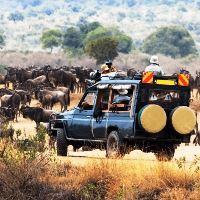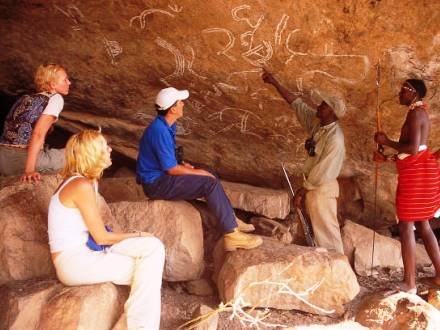 Kenya offers Icelandic visitors a wealth of cultural and historical wonders that span centuries, blending indigenous traditions with influences from the Indian Ocean trade routes. The country’s diverse heritage is reflected in its UNESCO-listed towns, sacred forests, and vibrant festivals, all of which provide unique opportunities for cultural immersion. For travelers from Iceland, where landscapes are shaped by ice and volcanic rock, Kenya’s warm climate and varied history can offer a striking contrast and unforgettable experiences. From the moment an Icelandic tourist steps into Kenya, the journey can include exploring the winding streets of Lamu Old Town, a Swahili settlement that has preserved its architectural and cultural integrity for over 700 years. The carved wooden doors, coral stone buildings, and dhow sailing culture offer a living museum of East African coastal life. Equally captivating is Fort Jesus in Mombasa, built by the Portuguese in the late 16th century to guard the harbor. Today, it serves as both a historical landmark and a window into the region’s colonial encounters. Inland, the Sacred Mijikenda Kaya Forests reveal another side of Kenya’s history. These forested sites, once fortified villages, hold spiritual significance for the Mijikenda people and are rich in biodiversity. Icelandic visitors interested in anthropology and ecology alike will find them a rewarding destination. Meanwhile, the Maasai Mara offers not only world-famous wildlife but also the chance to interact with Maasai communities, learning about their customs, beadwork, and traditional governance systems. Kenya’s cultural experiences are not confined to monuments and villages. Throughout the year, events such as the Lamu Cultural Festival celebrate traditional music, dance, storytelling, and boat races. Icelandic tourists who time their visit to coincide with such festivities can witness the vibrancy of Kenya’s living traditions. These gatherings bring communities together and invite visitors to participate, creating memories that extend beyond sightseeing. For Icelandic travelers, navigating Kenya is made easier by the widespread use of English, and many tour operators can tailor experiences to individual interests, whether historical, cultural, or natural. The diversity of Kenya’s cultural and historical sites means itineraries can be as varied as the visitors themselves; ranging from coastal heritage explorations to immersive tribal experiences. Kenya invites Icelandic visitors to step into a world where history is not just preserved in stone but lived in daily life. The rhythm of daily markets, the aroma of coastal spices, and the echoes of ancient songs blend seamlessly with centuries-old architecture and breathtaking natural backdrops. Every site, from Lamu’s narrow stone streets lined with intricately carved doors to the sweeping grasslands of the Maasai Mara plains, tells a layered story that bridges continents and centuries. Visitors can trace the paths of traders, warriors, and storytellers whose legacies still shape local customs today. For those seeking a deeper connection with the world’s cultural tapestry, Kenya offers a journey that engages all the senses inviting guests from Iceland to not only observe history but to feel, taste, and hear it in the vibrant present.
Kenya offers Icelandic visitors a wealth of cultural and historical wonders that span centuries, blending indigenous traditions with influences from the Indian Ocean trade routes. The country’s diverse heritage is reflected in its UNESCO-listed towns, sacred forests, and vibrant festivals, all of which provide unique opportunities for cultural immersion. For travelers from Iceland, where landscapes are shaped by ice and volcanic rock, Kenya’s warm climate and varied history can offer a striking contrast and unforgettable experiences. From the moment an Icelandic tourist steps into Kenya, the journey can include exploring the winding streets of Lamu Old Town, a Swahili settlement that has preserved its architectural and cultural integrity for over 700 years. The carved wooden doors, coral stone buildings, and dhow sailing culture offer a living museum of East African coastal life. Equally captivating is Fort Jesus in Mombasa, built by the Portuguese in the late 16th century to guard the harbor. Today, it serves as both a historical landmark and a window into the region’s colonial encounters. Inland, the Sacred Mijikenda Kaya Forests reveal another side of Kenya’s history. These forested sites, once fortified villages, hold spiritual significance for the Mijikenda people and are rich in biodiversity. Icelandic visitors interested in anthropology and ecology alike will find them a rewarding destination. Meanwhile, the Maasai Mara offers not only world-famous wildlife but also the chance to interact with Maasai communities, learning about their customs, beadwork, and traditional governance systems. Kenya’s cultural experiences are not confined to monuments and villages. Throughout the year, events such as the Lamu Cultural Festival celebrate traditional music, dance, storytelling, and boat races. Icelandic tourists who time their visit to coincide with such festivities can witness the vibrancy of Kenya’s living traditions. These gatherings bring communities together and invite visitors to participate, creating memories that extend beyond sightseeing. For Icelandic travelers, navigating Kenya is made easier by the widespread use of English, and many tour operators can tailor experiences to individual interests, whether historical, cultural, or natural. The diversity of Kenya’s cultural and historical sites means itineraries can be as varied as the visitors themselves; ranging from coastal heritage explorations to immersive tribal experiences. Kenya invites Icelandic visitors to step into a world where history is not just preserved in stone but lived in daily life. The rhythm of daily markets, the aroma of coastal spices, and the echoes of ancient songs blend seamlessly with centuries-old architecture and breathtaking natural backdrops. Every site, from Lamu’s narrow stone streets lined with intricately carved doors to the sweeping grasslands of the Maasai Mara plains, tells a layered story that bridges continents and centuries. Visitors can trace the paths of traders, warriors, and storytellers whose legacies still shape local customs today. For those seeking a deeper connection with the world’s cultural tapestry, Kenya offers a journey that engages all the senses inviting guests from Iceland to not only observe history but to feel, taste, and hear it in the vibrant present.
Top UNESCO and Cultural Experiences in Kenya for Iceland Tourists
| Site or Event | Location | Type | UNESCO Status |
|---|---|---|---|
| Lamu Old Town | Lamu Island | Historical/Cultural | Yes |
| Fort Jesus | Mombasa | Historical Landmark | Yes |
| Sacred Mijikenda Kaya Forests | Coastal Kenya | Spiritual/Cultural Site | Yes |
| Maasai Mara Villages | Narok County | Cultural Experience | No |
| Lamu Cultural Festival | Lamu Island | Cultural Event | No |
Top Cultural Heritage Attractions in Kenya for Icelandic Tourists
For Icelandic tourists eager to discover Kenya’s cultural heart, the nation offers a fascinating blend of experiences that connect visitors to centuries-old traditions and remarkable landmarks. These attractions are more than just beautiful sights they are living narratives that showcase Kenya’s diverse communities, rich history, and enduring cultural pride. From bustling coastal cities steeped in Swahili heritage to inland communities preserving ancestral ways of life, the options are vast. Many attractions are supported by local guides, whose deep knowledge and personal narratives provide layers of meaning that transform a simple visit into an immersive learning experience. These guides often share folklore, lesser-known historical facts, and cultural insights passed down through generations, allowing travelers from Iceland to connect with Kenya on a personal level. Walking through ancient streets or sacred forests with a guide becomes an opportunity to ask questions, engage in conversations, and gain perspectives that are not found in guidebooks. By exploring these cultural treasures with local expertise, visitors not only witness Kenya’s past through its landmarks but also experience its living culture in markets, workshops, and community spaces. The interaction fosters mutual appreciation by encouraging genuine dialogue and shared experiences between visitors and local hosts. Icelandic travelers often find they gain a deeper, more nuanced understanding of Kenya’s heritage, not only by observing its monuments but also by engaging directly with the people who sustain its traditions. Communities, in turn, benefit from cultural exchange that can strengthen pride in local customs and support sustainable tourism initiatives aimed at preserving historical sites. This reciprocity turns sightseeing into a journey of discovery, where the past is enriched by present-day encounters. Icelandic guests can immerse themselves in Kenya’s vibrant contemporary culture; from market stalls brimming with handmade crafts to workshops teaching age-old skills; while also tracing the stories etched into the land’s architecture and landscapes. By blending historical exploration with living culture, the experience becomes both educational and emotionally resonant. Icelandic travelers can taste the flavors of Kenyan cuisine, hear the rhythmic beats of traditional drums, and see age-old crafts being made by skilled artisans. Every sensory encounter adds depth to the understanding of the country’s identity, linking its rich history to the vibrancy of its present-day culture. This holistic approach ensures that a trip to Kenya is not just about visiting monuments or ticking locations off a list; it’s about forging personal connections with people, places, and traditions. Over time, these connections can inspire a greater appreciation for cultural diversity and the shared human experiences that transcend borders. Such a journey leaves lasting memories that carry the warmth of Kenyan hospitality and the wisdom of its heritage long after returning home to Iceland.
Best Historical Places in Kenya to Visit for Travelers from Iceland
Kenya offers a treasure trove of historical sites that fascinate travelers from Iceland seeking culture, history, and adventure. The country’s diverse past, influenced by African, Arab, Asian, and European interactions, is visible in its architecture, monuments, and preserved towns. Whether walking through ancient coastal streets, visiting fortresses, or exploring sacred landscapes, visitors can uncover stories spanning centuries. This guide highlights the best historical places in Kenya for Icelandic travelers, providing insights into what makes each site unique. Each destination offers a mix of historical depth and cultural vibrancy, ensuring a memorable journey for those who value heritage-rich experiences.
- Lamu Old Town: Established in the 14th century, Lamu Old Town is a UNESCO World Heritage Site known for its Swahili architecture, coral stone buildings, and narrow alleys. Icelandic visitors can enjoy the relaxed pace, dhows sailing in the harbor, and bustling markets offering handmade crafts. Local guides share tales of trade, religion, and culture, making it easy to picture life centuries ago. The town remains a living community, offering both history and the warmth of coastal hospitality.
- Fort Jesus, Mombasa: Built by the Portuguese in 1593, Fort Jesus served as a coastal defense and a symbol of strategic power. Today, its preserved bastions, gun turrets, and exhibition halls tell the story of colonial competition along the East African coast. Icelandic tourists can walk its ramparts while learning about sieges, trade, and cultural exchanges. Exhibits inside the fort showcase artifacts from centuries of maritime history, making it a must-see for history enthusiasts.
- Sacred Mijikenda Kaya Forests: These forests, once fortified villages, are sacred to the Mijikenda people and recognized by UNESCO for their cultural and ecological importance. Icelandic visitors can explore guided trails, learning about indigenous spirituality, traditional governance, and forest conservation. The sites offer insight into a deep-rooted respect for nature that resonates with Icelandic values of preserving landscapes. Each kaya has its own history and rituals, making them uniquely compelling to culturally curious travelers.
- Gede Ruins: Hidden in coastal forests, the Gede Ruins are the remains of a Swahili town dating back to the 12th century. Excavated structures include mosques, palaces, and houses built from coral stone. Icelandic visitors can explore the archaeological site, imagining the bustling life of traders who once inhabited the area. Informative displays and knowledgeable guides provide context about the town’s mysterious abandonment, adding an air of intrigue to this historical gem.
- Karen Blixen Museum: Located in Nairobi, this museum is the former home of Danish author Karen Blixen, famous for her memoir Out of Africa. The preserved farmhouse offers a glimpse into colonial life in early 20th-century Kenya. Icelandic visitors can tour the rooms, gardens, and learn about Blixen’s literary work, farming challenges, and relationship with the local Kikuyu community. The site combines literary history with the charm of Kenya’s highland landscapes.
- Maasai Mara Villages: While famed for wildlife, the Maasai Mara also offers historical and cultural depth through visits to Maasai villages. Icelandic travelers can experience traditional housing, beadwork, and ceremonies passed down for generations. Guides explain the Maasai’s semi-nomadic lifestyle, social structures, and resilience in preserving their culture. These encounters provide a living history lesson, enriching any trip to the Mara with human heritage alongside natural wonders.
For travelers from Iceland, Kenya’s historical sites offer more than sightseeing they provide immersive journeys into the country’s soul. From ancient towns and sacred forests to colonial-era landmarks and vibrant tribal communities, each destination reveals a facet of Kenya’s diverse history. The combination of well-preserved heritage and living traditions ensures that every visit feels authentic and meaningful. By exploring these places, Icelandic visitors not only witness history but also engage with the people and stories that keep it alive. Kenya’s past and present blend beautifully, creating travel experiences that linger long after the return flight home.
Ancient Landmarks and Monuments in Kenya for Icelandic Sightseers
 Kenya’s ancient landmarks and monuments hold layers of history that Icelandic sightseers will find both educational and inspiring. Across the country, centuries-old sites reveal the stories of early coastal trade, indigenous kingdoms, and colonial-era encounters. From the imposing walls of Fort Jesus in Mombasa to the atmospheric ruins of Gede hidden in lush forest, these monuments offer a tangible link to the past. Visitors from Iceland, accustomed to their own saga-rich heritage, will appreciate how Kenya’s history is etched into coral stone, earthworks, and sacred spaces. Many of these destinations are UNESCO-recognized, underscoring their global cultural value and importance in preserving human history. Each site not only showcases architectural skill but also reflects the diverse influences; Arab, Portuguese, African, and Asian; that have shaped Kenya over the centuries. With well-maintained access points, informative guides, and proximity to vibrant towns, these landmarks are ideal additions to a cultural itinerary. Icelandic travelers can begin their exploration at coastal forts that once safeguarded vital trade routes, continue inland to ancient ruins that whisper of once-thriving settlements, and finish among sacred spaces still revered by local communities. The opportunity to hear oral histories from guides and elders deepens the experience, turning sightseeing into storytelling. Visiting these places offers a vivid narrative of resilience, trade, spirituality, and artistry that spans millennia. Each journey enriches understanding of East Africa’s evolving role in global history, while drawing parallels to Iceland’s own traditions of preserving cultural identity through heritage sites and storytelling. Icelandic visitors may recognize familiar themes in Kenya’s commitment to safeguarding its heritage, from oral traditions passed through generations to the careful maintenance of historical landmarks. These parallels create a deeper bond between travelers and hosts, fostering a mutual respect that transcends geography. This shared appreciation underscores how communities safeguard their legacies across continents and generations, and it can be expanded into a richer narrative. Around the world, people play an active role in protecting customs, languages, rituals, and artistry, ensuring these treasures remain vibrant in daily life rather than fading into obscurity. In Kenya, this commitment might mean maintaining sacred sites with careful stewardship, passing down oral histories around evening fires, or celebrating age-old festivals that unite communities. For Icelandic visitors, witnessing these living traditions resonates deeply with their own preservation efforts whether conserving sagas, protecting turf houses, or keeping ancient music alive. Both nations share the understanding that culture must be continually adapted and celebrated to survive. In Iceland, harsh landscapes and close-knit communities have nurtured traditions that adapt to modern realities, just as in Kenya, where diverse peoples weave the old with the new. These parallels foster mutual respect and inspire travelers to see their own heritage through a fresh lens. In both cases, culture is not frozen in time; it remains a living, evolving force, enriched by each generation that chooses to honor and sustain it.
Kenya’s ancient landmarks and monuments hold layers of history that Icelandic sightseers will find both educational and inspiring. Across the country, centuries-old sites reveal the stories of early coastal trade, indigenous kingdoms, and colonial-era encounters. From the imposing walls of Fort Jesus in Mombasa to the atmospheric ruins of Gede hidden in lush forest, these monuments offer a tangible link to the past. Visitors from Iceland, accustomed to their own saga-rich heritage, will appreciate how Kenya’s history is etched into coral stone, earthworks, and sacred spaces. Many of these destinations are UNESCO-recognized, underscoring their global cultural value and importance in preserving human history. Each site not only showcases architectural skill but also reflects the diverse influences; Arab, Portuguese, African, and Asian; that have shaped Kenya over the centuries. With well-maintained access points, informative guides, and proximity to vibrant towns, these landmarks are ideal additions to a cultural itinerary. Icelandic travelers can begin their exploration at coastal forts that once safeguarded vital trade routes, continue inland to ancient ruins that whisper of once-thriving settlements, and finish among sacred spaces still revered by local communities. The opportunity to hear oral histories from guides and elders deepens the experience, turning sightseeing into storytelling. Visiting these places offers a vivid narrative of resilience, trade, spirituality, and artistry that spans millennia. Each journey enriches understanding of East Africa’s evolving role in global history, while drawing parallels to Iceland’s own traditions of preserving cultural identity through heritage sites and storytelling. Icelandic visitors may recognize familiar themes in Kenya’s commitment to safeguarding its heritage, from oral traditions passed through generations to the careful maintenance of historical landmarks. These parallels create a deeper bond between travelers and hosts, fostering a mutual respect that transcends geography. This shared appreciation underscores how communities safeguard their legacies across continents and generations, and it can be expanded into a richer narrative. Around the world, people play an active role in protecting customs, languages, rituals, and artistry, ensuring these treasures remain vibrant in daily life rather than fading into obscurity. In Kenya, this commitment might mean maintaining sacred sites with careful stewardship, passing down oral histories around evening fires, or celebrating age-old festivals that unite communities. For Icelandic visitors, witnessing these living traditions resonates deeply with their own preservation efforts whether conserving sagas, protecting turf houses, or keeping ancient music alive. Both nations share the understanding that culture must be continually adapted and celebrated to survive. In Iceland, harsh landscapes and close-knit communities have nurtured traditions that adapt to modern realities, just as in Kenya, where diverse peoples weave the old with the new. These parallels foster mutual respect and inspire travelers to see their own heritage through a fresh lens. In both cases, culture is not frozen in time; it remains a living, evolving force, enriched by each generation that chooses to honor and sustain it.
Must-See Ancient Sites in Kenya for Icelandic Cultural Enthusiasts
Kenya is home to a remarkable array of ancient sites that fascinate Icelandic cultural enthusiasts with their blend of history, architecture, and living traditions. From the windswept coasts to the green highlands, these locations reveal centuries of human endeavor and cultural exchange. Lamu Old Town stands as a testament to Swahili culture, its coral stone buildings and carved doors reflecting influences from Arab and Asian traders. Inland, the Sacred Mijikenda Kaya Forests preserve the spiritual heritage of the Mijikenda people, offering trails that wind through lush vegetation steeped in legend. Gede Ruins, hidden within coastal forests, whisper of a once-thriving trade hub mysteriously abandoned in the 17th century. Fort Jesus in Mombasa showcases military architecture and colonial history, while Thimlich Ohinga in the west reveals intricate dry-stone fortifications of ancient communities. For Icelandic visitors, exploring these sites is more than a lesson in history it’s a chance to engage with Kenya’s enduring spirit, experience its storytelling traditions, and draw connections between two nations that value the preservation of their unique cultural landscapes. These destinations create a vivid narrative of resilience, artistry, and heritage that continues to inspire across continents, and expanding on their significance reveals deeper cultural connections. Each location holds layers of meaning shaped by centuries of interaction between cultures, climates, and communities, leaving behind not only physical monuments but living traditions. For Icelandic travelers, exploring these historic landscapes can feel like stepping into a shared chapter of global history, where architectural details speak of skilled craftsmanship, oral traditions preserve collective memory, and spiritual practices keep ancient beliefs alive. Such encounters naturally spark parallels with Iceland’s own heritage, where sagas, stone buildings, and seasonal rituals hold a similar cultural weight. The connection bridges vast distances through universal themes of creativity, perseverance, and identity, underscoring that heritage is a dynamic, evolving force. These experiences invite deep reflection on how history actively shapes the present and guides the future. For Icelandic travelers, encountering Kenya’s ancient sites and living traditions can prompt comparisons with their own heritage, highlighting universal themes of endurance, adaptation, and cultural pride. The stories embedded in architecture, rituals, and art become living lessons, encouraging visitors to embrace resilience in their own lives. By carrying forward these insights, travelers contribute actively to the preservation and celebration of Kenya’s cultural legacy, ensuring that the stories, skills, and traditions they encounter continue to thrive for generations to come. This act of cultural stewardship fosters a shared respect for the diverse histories that shape our world, encouraging dialogue, empathy, and understanding between communities that may be separated by vast distances. For Icelandic visitors, it means returning home not only with photographs, but with a deeper appreciation for how cultural exchange strengthens global bonds, enriches personal identity, and supports the resilience of heritage worldwide.
Immersive Cultural Experiences in Kenya for Icelandic Adventurers
Kenya offers Icelandic adventurers a diverse array of immersive cultural experiences that extend far beyond traditional sightseeing. Visitors are welcomed into Kenyan communities where daily life seamlessly blends with customs and traditions passed down for centuries. Many Icelandic travelers find themselves invited to share meals, join seasonal celebrations, or witness local ceremonies, gaining a first-hand appreciation of Kenya’s warm hospitality. Maasai village visits provide hands-on opportunities to try beadwork, prepare traditional dishes, or learn local dances from skilled artisans. These participatory moments bridge cultural gaps and create lasting memories that go beyond photography. Storytelling is another powerful element of Kenyan culture, with elders recounting myths, legends, and historical events that connect past and present. Such narratives resonate strongly with Iceland’s own oral traditions, which preserve the sagas of ancestors. Sensory impressions abound; the scent of coastal spices drifting from market stalls, the deep rhythmic beats of drums during community gatherings, and the vivid colors of traditional attire all work together to immerse visitors in a vibrant cultural landscape. Exploring local markets reveals handmade crafts, woven baskets, and intricate jewelry, offering a tangible connection to artistry practiced for generations. Music and dance performances invite participation, letting guests feel the pulse of the culture through movement and rhythm. These vibrant showcases often begin with traditional instruments; drums, lyres, and flutes; that set an infectious beat, drawing visitors into the circle. Icelandic travelers may join dancers in intricate steps, guided by the rhythm and the energy of the crowd. Such interactions are more than entertainment; they create authentic bonds between hosts and guests. These exchanges foster mutual understanding, empathy, and respect, ensuring that Icelandic visitors depart with heartfelt connections to Kenya’s living heritage. The joy of shared performance breaks down language barriers, replacing words with movement and music. These moments often spark deep reflection on the shared human values of community, tradition, adaptability, and celebration that unite people across continents. For Icelandic travelers, witnessing these expressions in Kenya highlights striking parallels with their own heritage, from storytelling and music to communal gatherings that strengthen bonds. Such experiences remind visitors that cultural expression is a universal language one that transcends words, geography, and even climate capable of building bridges across vastly different landscapes and histories. In doing so, it encourages respect, empathy, and a lasting appreciation for the diversity and resilience of human traditions worldwide.
Traditional Cultural Events and Festivals in Kenya for Iceland Tourists
Kenya’s traditional cultural events and festivals offer Icelandic tourists an unforgettable window into the nation’s living heritage. From vibrant coastal celebrations to sacred ceremonies in rural communities, these gatherings are opportunities to witness traditions passed down through generations. They blend music, dance, crafts, food, and storytelling into immersive experiences that welcome visitors to join in. For Icelandic travelers accustomed to their own midsummer festivals and folklore-rich traditions, Kenya’s events provide both contrasts and connections. The following highlights showcase some of the most memorable occasions, each explained in detail to help visitors plan a culturally rich journey.
- Lamu Cultural Festival: Held annually on Lamu Island, this event celebrates Swahili culture with dhow races, traditional dances, poetry readings, and craft displays. Icelandic visitors can wander the narrow streets to watch artisans at work, taste local delicacies, and join friendly competitions. The festival fosters community spirit and offers a vivid insight into coastal heritage, making it a colorful and interactive experience.
- Maasai Mara Ceremonies: Visitors to Maasai communities may witness age-grade ceremonies marking life transitions, such as coming-of-age rituals. These involve traditional songs, beadwork, and community feasts. For Icelandic travelers, it’s a chance to understand the Maasai’s resilience in preserving their customs while adapting to modern life, providing a deep cultural exchange.
- Mombasa Carnival: Known as Kenya’s largest street party, this November event features parades, floats, music, and dancers in elaborate costumes. Icelandic tourists will enjoy the high-energy atmosphere, sampling coastal cuisine while watching performers showcase the region’s cultural diversity.
- Turkana Cultural Festival: Set in northern Kenya, this festival gathers over a dozen ethnic groups for performances, storytelling, and traditional games. It offers Icelandic visitors a rare opportunity to experience Kenya’s cultural variety in one place, fostering unity through shared celebration.
For Icelandic tourists, attending Kenya’s traditional events and festivals transforms a holiday into an immersive cultural journey. These gatherings are not staged spectacles; they are authentic expressions of community pride, often rooted in historical traditions that have adapted to modern times. Participating in such events allows travelers to experience the heartbeat of Kenyan society; through its music, dances, cuisine, and crafts; while forming genuine connections with locals. The Lamu Cultural Festival, with its mix of dhow races and Swahili poetry, invites visitors to explore a heritage shaped by centuries of Indian Ocean trade. Maasai ceremonies open a window into a pastoralist way of life that values communal bonds and age-old customs. Meanwhile, Mombasa Carnival’s exuberant energy reflects the city’s cosmopolitan spirit, bringing together people of all backgrounds in joyful celebration. In the remote north, the Turkana Cultural Festival unites diverse ethnic communities, creating a living tapestry of traditions. These experiences resonate strongly with Icelandic visitors, whose own cultural identity is deeply tied to seasonal celebrations, storytelling, and artistic expression. Just as Iceland’s Þorrablót or midsummer gatherings keep history alive, Kenya’s festivals sustain and evolve cultural memory. By joining in, travelers not only observe but participate; dancing, tasting, and learning alongside hosts. The result is a deeper appreciation for shared human creativity and resilience. Such encounters ensure that the memories taken home are not just of places visited, but of friendships formed and cultures understood, making the journey truly unforgettable.



